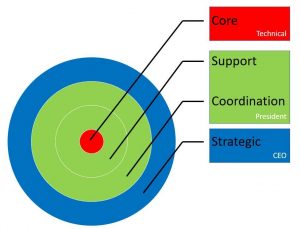Index:
- SEO and Your Inbound Marketing Strategy – Part 1
- SEO and Your Inbound Marketing Strategy – Part 2
- SEO and Your Inbound Marketing Strategy – Part 3
Optimization Before You Even Write a Word
There are many ideas about what makes up a good inbound marketing strategy, but there is one thing that always makes the list.
Eric Wittlake, in his article 5 Key Elements of Inbound Marketing insists that writing great content is at the core of inbound, but search engine optimization is on the list.
The folks over at Brick Marketing think that there are three components to every inbound program and they are social media, SEO and content marketing.
HubSpot has built an entire movement around their inbound marketing theology of Attract, Convert, Close, and Delight (which includes SEO in the mix).
Although the theologies differ on the basics that make up a good inbound program, an inbound marketing expert can agree on two things. First, there is no such thing as an inbound expert. Second, SEO is a vital component of the entire inbound process.
Related Resources from B2C
» Free Webcast: Social Listening – Gateway to Innovation
Let’s take a look at how search engine optimization affects the inbound marketing efforts of your business, before you even write your first blog:
WHAT IS SEO AGAIN?
Search Engine Optimization is basically about making your website more appealing for Google, Yahoo and Bing to come and crawl all over your content and see if it is worthy to be ranked higher in their results. Kind of creepy huh? And yet Inbound Marketing Strategies have good SEO sprinkled everywhere so those engine spiders can grow fat on SEO.
Why? Because people all over the place are using search engines to find information about your business. According to HubSpot, 79% of online shoppers are spending 50% of their shopping time doing research. Remember this later when we discuss lead nurturing.
Using carefully researched keyword strategies throughout every component of your inbound process can get you powerful results.
SEO AND BUYER PERSONAS
The first place to look when you are forming your SEO strategy is at your Buyer Persona. Who are you marketing to? Who do you want to sell your product or service to?
It may not sound like much, but there are probably two or three main buyer groups that you can identify as your personas.
Creating your persona can be a fun process, as well as very educational. Understanding the exact nature of your potential customers, which translate into possible website visitors, is an important part of your SEO strategy and making sure you get your message to the right people.
In addition to getting your content to the right people, as a business person who is trying to foster leads into the inbound equation, you want to get the right content to the right people at the right time.
The stage of the buying process that your visitor (turned lead) is in will have a great impact on what you want to say to them.
For example, if you are a small business man who sells widgets, are you trying to appeal to other businessmen? Or maybe you need to attract a stay-at-home mom who lives in the suburbs. Perhaps your potential visitor is a millennial who lives in the city or even a young family who needs to find the right widget for their needs.
Building personas around your target markets and then picking SEO keywords just for them will save you time, money and lots of marketing ROI when you utilize them.
PICKING KEY WORDS
Once you have an idea of who your potential website visitors are, it will be easier to identify the keywords you need to get them there.
It is time to pick out some key words to attract visitors to your website. Google, Yahoo and Bing will be the main lines to your potential buyer.
When choosing your keyword strategy think about each of your buyers and the questions they would ask when they sit down to a computer to research your product or service. How would they type in a research term regarding your product?
Examples include:
- limo companies in Nashville
- management consulting in Atlanta
- best cupcakes in Brentwood
- who sells phone systems in LA
- how do I organize my taxes
It may seem a little daunting to come up with keyword strategies, but the research is worth it. The words you choose are going to go with you throughout the rest of your inbound process. Your keywords will be splashed throughout your website, your social media platforms and your lead nurturing process.
Choose them wisely.
Google Adwords is a fabulous free tool to use when you are crafting your keyword strategies.
HOW TO GET ONTO GOOGLE ADWORDS
Go to Google’s Adwords Page and click on “Get Started Now”. When you are entering your business name and your website address, remember that you will not have to pay anything to use Google Adwords. You will also need to enter good things like your time zone and the country you live in.
Don’t worry, the pain is short. You will soon be presented with a CONGRATULATIONS page. Just hit the key at the bottom that says “I know the basics” can we get on with this please?
Once you get your Adwords account go to the homepage.
Then click on Tools and Keyword Planner
Once you get to keyword central, you are going to want to play around a little bit. Research one word, two words together and three to four keyword phrases.
Here is some great news. You can also look up the keywords that your competitors are ranking for and use them in your SEO process.
SITE ORGANIZATION
When you decide on your buyer personas, and you have a solid product or service to sell to them, how your website is set up is yet another way to make sure that search engines find you.
Does a visitor to your website have to click five times to get to the content they need? A search engine wants to be able to crawl your website just as easily. Websites that are old, clunky and slow to load are a nuisance to engine spiders.
If a website has too many layers to it, the search engines may grow tired of digging so deeply in order to index every page. They may just assume that the deeper layers of a website stay the same and will only visit them every once in a while for ranking efforts.
Building a website that is lighter and more navigable by the crawlers is the best way to make sure their visit is comfortable and inviting.
Come on in website crawler,
my domain is immaculate.
No pages hacked with tags,
no fake SEO going on here.
And certainly no H4’s.
Does any of the language here scare you? It really shouldn’t. A little bit of Inbound Education would serve you well, or maybe a certified inbound agent can help you find your way through the SEO pitstop and get you started on the inbound highway .
XML SITEMAPS & SCHEMA MARKUPS
As if the site set up wasn’t enough for you, there’s more scary inbound language to consider when you are creating an SEO strategy.
When a new website goes live there is no guarantee that search engines are going to find it. In fact, a link to the site it what usually triggers search engines to come crawling.
Creating an XML sitemap or a schema markup is a way to make it easy for search engines to see that you are out there. It says, “I have pages and html’s and they are available to be crawled.” XML is Match.com for search engines.
If you can’t find a way to do it yourself, have your web designer or inbound agent prepare one for you that has your URLs and other metadata so that search engines can pick you up more easily.
Although it is no guarantee, adding XML maps or schema markups to your site code certainly make the odds better that Google will pick up your site and include it in rankings.
Creating buyer personas, choosing pinpoint keywords, proper site organization and creating XML sitemaps are each a vital component of making sure that your inbound process is utilizing SEO to its maximum potential. Making sure that your website is razor focused on the right audience and highly attractive to search engines even before you go live takes planning and research to ensure the success of your business and creating more leads.
In part two of this article we are going to reveal the parts of the inbound process that are affected by SEO WHEN you begin writing content. The blog, the landing page and other pages, as well as your social media platforms and how you engage all should take SEO into consideration.
Author: Jeff Evans Jeff Evans on the Web
Read more at business2community.com
(823)




